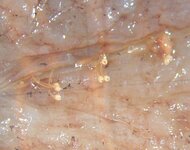- Joined
- Nov 19, 2002
- Messages
- 2,107
OK, gang. Got a puzzle for you. I don't know the answer myself, and have spent a good long while mentally turning over the pieces without making any headway.
Males of the family Onychoteuthidae are known to mate by hydraulically implanting spermatophores (packets of sperm) into the mantle musculature of the female. In some genera, these spermatophores are implanted in rows, in longitudinal cuts that, we assume, are made by the male's hooks or beak.
While at the Smithsonian, I observed a spent female Onychoteuthis, with spermatophores implanted in ventral cuts in her mantle tissue, similar to those photographed near the bottom of this page on the Tree of Life. In the Smithsonian specimen, the cuts were longitudinal, but the strangest thing was the implanted spermatophores. They were implanted in bunches, with most of the spermatophore embedded in the tissue perpendicular to the cut, but the part of each spermatophore that remained protruding from the external surface of the female's tissue had a weird, hollow round bulb at the end of it (see attached photo). Now, I also observed several specimens of what I believe were males from the same species, and their spermatophores (un-discharged) did not have this structure. I have seen the same thing on a male/female pair from a different species of Onychoteuthis from Australia as well - the spent female has these bulb-tipped spermatophores implanted in cuts, while the male has very different spermatophores, in this case implanted in his own viscera, which I assume happened during capture. (Fairly common.)
Soooooo, anyone want to take a crack at what could be going on here??? Are the bulbs an artefact of the force with which the spermatophores are implanted? Why are they hollow? Why do they look like they exploded? Are they functional in some way? If they are an artefact of implantation, why didn't the male of the Australian species have them on the spermatophores embedded in his mantle?
Speculations are most welcome! The wilder the better! Welcome to an eensy-weensy but representative corner of my thesis.
Males of the family Onychoteuthidae are known to mate by hydraulically implanting spermatophores (packets of sperm) into the mantle musculature of the female. In some genera, these spermatophores are implanted in rows, in longitudinal cuts that, we assume, are made by the male's hooks or beak.
While at the Smithsonian, I observed a spent female Onychoteuthis, with spermatophores implanted in ventral cuts in her mantle tissue, similar to those photographed near the bottom of this page on the Tree of Life. In the Smithsonian specimen, the cuts were longitudinal, but the strangest thing was the implanted spermatophores. They were implanted in bunches, with most of the spermatophore embedded in the tissue perpendicular to the cut, but the part of each spermatophore that remained protruding from the external surface of the female's tissue had a weird, hollow round bulb at the end of it (see attached photo). Now, I also observed several specimens of what I believe were males from the same species, and their spermatophores (un-discharged) did not have this structure. I have seen the same thing on a male/female pair from a different species of Onychoteuthis from Australia as well - the spent female has these bulb-tipped spermatophores implanted in cuts, while the male has very different spermatophores, in this case implanted in his own viscera, which I assume happened during capture. (Fairly common.)
Soooooo, anyone want to take a crack at what could be going on here??? Are the bulbs an artefact of the force with which the spermatophores are implanted? Why are they hollow? Why do they look like they exploded? Are they functional in some way? If they are an artefact of implantation, why didn't the male of the Australian species have them on the spermatophores embedded in his mantle?
Speculations are most welcome! The wilder the better! Welcome to an eensy-weensy but representative corner of my thesis.




 my crackpot theory because everybody who's anybody knows it can't work that way...
my crackpot theory because everybody who's anybody knows it can't work that way... Ongoing thought required!
Ongoing thought required!